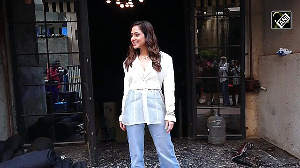Investing is no longer as easy as opening a bank fixed deposit and parking money in a post office scheme. With so many attractive avenues in the market today, it is in your best interest to chalk out a plan for 2007 to make the most of the opportunities.
And to help you out with this task, CNBC TV 18 spoke to experts Arpit Agarwal of Dawnay Day and Puneet Nanda of ICICI Prudential.
In the year 2007, how should one breakup his/her portfolio between asset classes assuming its not a very conservative portfolio, neither terribly aggressive?
Puneet Nanda: As you said it rightly, the most important thing to concentrate on is asset allocation rather than things like stock picking and so on. But when one looks at asset allocation, you must answer these three questions: What are your financial goals? What is your risk appetite? What is your time horizon?
Markets tend to be very volatile by nature and more so in recent times, which is why one needs to take a long-term call, i.e. three to five years, when one is deciding about asset allocation.
|
Puneet Nanda says: |
|
|
Aggressive investor |
|
|
Equity |
60% |
|
Fixed income, including cash |
15% |
|
Real estate |
15% |
|
Commodities, mainly gold |
10% |
|
Conservative investor |
|
|
Equity |
30% |
|
Fixed income, including cash |
30% |
|
Real estate |
25% |
|
Commodities, mainly gold |
15% |
However, if one assumes that the objective is simply wealth maximization, then one has to look at the risk appetite. One can probably look at a conservative individual and an aggressive individual.
If I was an aggressive individual, I would probably invest 60% in equity, 15% in fixed income instruments. It could include cash, in fact at current point of time it would be a short term instruments. I would invest another 15% in real estate and remaining 10% in a bunch of commodities, which is primarily gold in the Indian market today.
But on the other hand, if I was a conservative investor I would look at returns per unit of risk rather than returns per se. That's where the conservatism comes in. I would probably put about 30% in equity at this point of time and another 30% in some kind of fixed income instruments including cash, 25% in real estate and maybe the remaining 15% in commodities, including gold.
Arpit Agarwal: Background to what happen in 2006, it has been a dream 2006 and both the investors as well as the manufacturers are in a euphoria that everything is going great. Whatever you put on the table sells or whatever you buy off the table, gives you 20%, 30% or even 40% of returns.
With that background, when you move into 2007, aggression will be the underlying scene for investors as well as manufacturers.
So I would say, just be a little cautious and reduce volatility in the portfolio, at the same time, do not get too defensive and start getting into fixed income. Fixed income gives you 7-9%, which in my view is ultra conservative considering the way India is doing today.
|
Arpit Agarwal says: |
|
|
Large caps, long-term growth stocks |
30-35% |
|
Mid caps and small caps |
10-15% |
|
Real estate |
20-25% |
|
Commodities, mainly gold and silver |
10-15% |
|
Fixed income, including bank fixed deposits and cash |
10-15% |
So probably, what I would do is take about 50% of the portfolio and stay in long-term equities. Typically, within that 50%, I would invest about 60-70% in largecaps, long-term, growth stocks and put the balance 30% or 40% in midcap and smallcaps to get the opportunities.
Of the remaining 50%, I would put in 20-25% in real estate but be absolutely sure what kind of real estate you are buying. Do not just go and buy anything or anywhere. Hopefully, by 2007, if we have real estate investment trust coming in, it will make life a lot easier for the investors. Investing in real estate would serve as the hedge against inflation.
Now, you are left with about 20-25%. Probably, the investor should diversify into non-ferrous metals; gold, silver is anyway there and you can look at putting in 10-15% of your money in commodities. Now you are left with 10-15% as cash.
People keep cash in their savings bank account to take short-term opportunities like arbitrage or sectoral play or individual stock play. Ideally, what they should do is put that money in a long-term fixed deposit in a triple A rated bank. What it gives you is 8-8.5%, 3-5 year interest rate. And then you can borrow against that fixed deposit. Banks will lend you 90-95% at 2% above the deposit rate for these short-term arbitrage opportunities.
So you maximize your fixed income portfolio, you have an underlying real estate and a strong underlying 30-40% equity portfolio and you have a good 30-40% left to arbitrage and take short-term opportunities.
When you say fixed income what's the best product? Do you mean Reserve Bank of India (RBI) tax saving or do you put it in an actively managed bond fund from a mutual fund basket? What is the best way to approach a fixed income basket?
Puneet Nanda: There are a number of instruments like RBI bonds, small saving instruments, mutual funds schemes, bank deposits which is an asset class by itself. Also, insurance companies have these new age products called the unit-linked products wherein again similar options are available in terms of different fund classes.
So it could be either in one or in the mix of all. At this point of time, given the view that interest rates probably still have some way to go in terms of going up, it would be more appropriate to either lock in to some kind of fixed rates where there is no market risk.
This is the case perhaps in mutual fund or in short-term instrument. For example; if one is looking at the mutual fund option, one should look at short-term funds or liquid funds and so on. Alternatively, one could look at either some kind of small savings instruments, which have a fixed return, like bank deposits or short term fund options in ULIPs so it's not subject to market fluctuations.
When you say 50-60% equity for people who are not very active traders or investors and say are medium to high net worth, would you advice them to look at PMSs or structured product from brokerages or go for the vanilla mutual fund offerings?
Arpit Agarwal: I would recommend if my equity component of my portfolio is Rs 100, I would put in at least 70-75% with quality long term asset management companies because they have the fund managers who will look after these monies. I can always take away 20-25% of that Rs 100 and go in to PMSs or try doing something of my own.
So, my core underlying portfolio is with qualified investors and they look after it. If I make money on my 25%, I can keep myself excited with that 25% because people don't want to be passive, they actually want to participate. Five percent of the overall portfolio should be kept for that excitement. If they make money then great.
What is the best way to play commodities because a lot of people are interested in it but do not want to own physical gold since it is a relatively newer market. How would you advise people to go about investing on that side?
Arpit Agarwal: A couple of days ago, we read in the leading dailies that SEBI is looking at launching gold ETFs. By 2007, I would probably see that the regulators may launch probably a gold ETF or another commodity ETF and that would be the best way for those who are in commodities.
But I guess commodities will probably feature in more as alternatives into structured products, which manufacturers will throw in and that is how investors should take that.
For more on markets & business, log on to www.moneycontrol.com.







 © 2025
© 2025